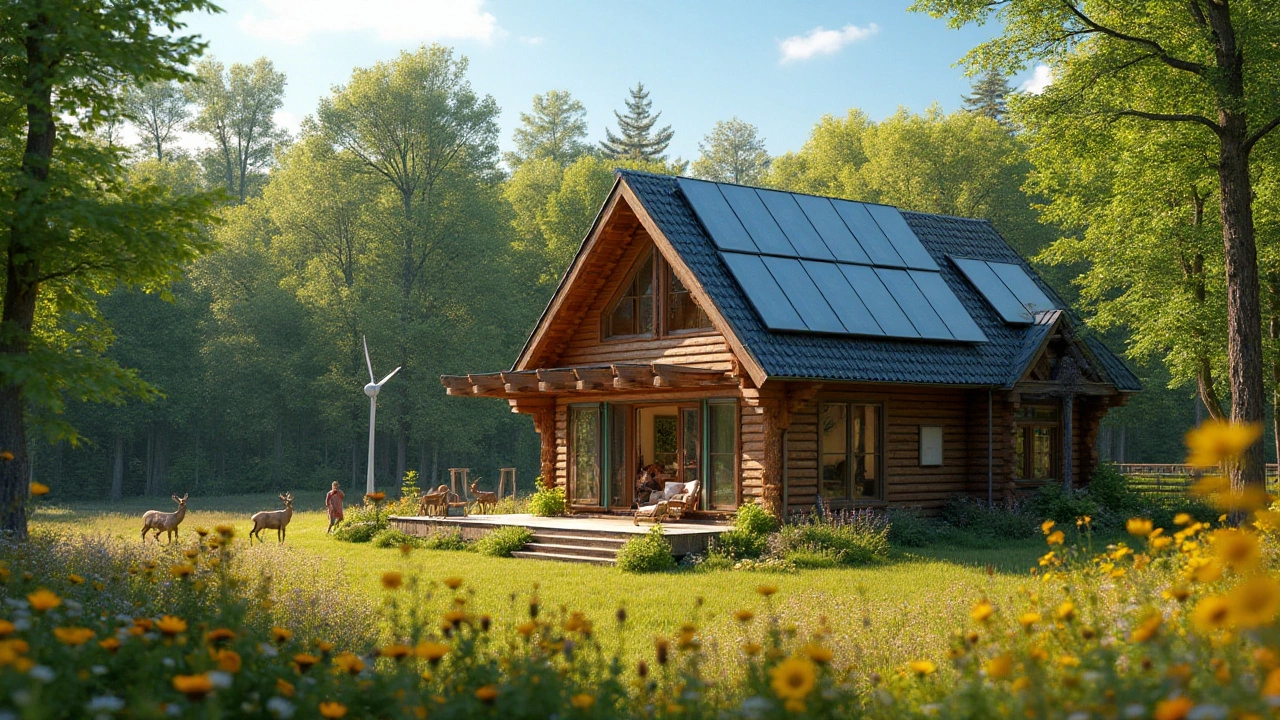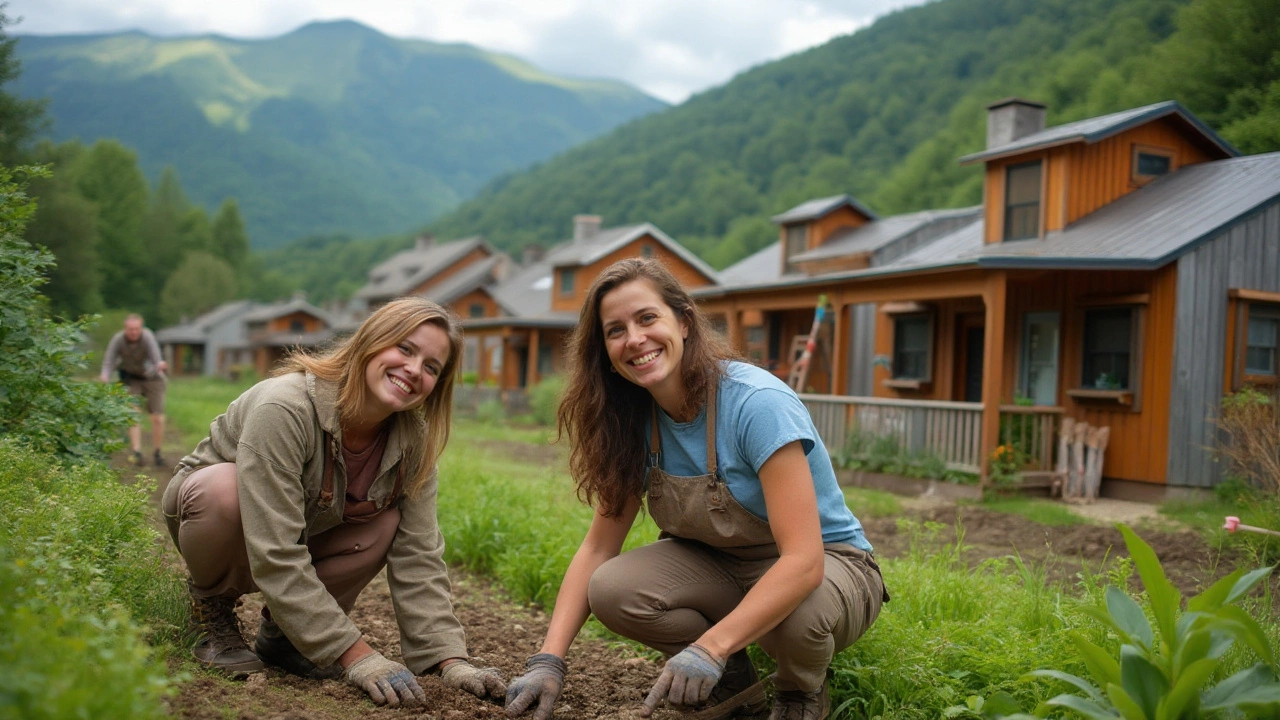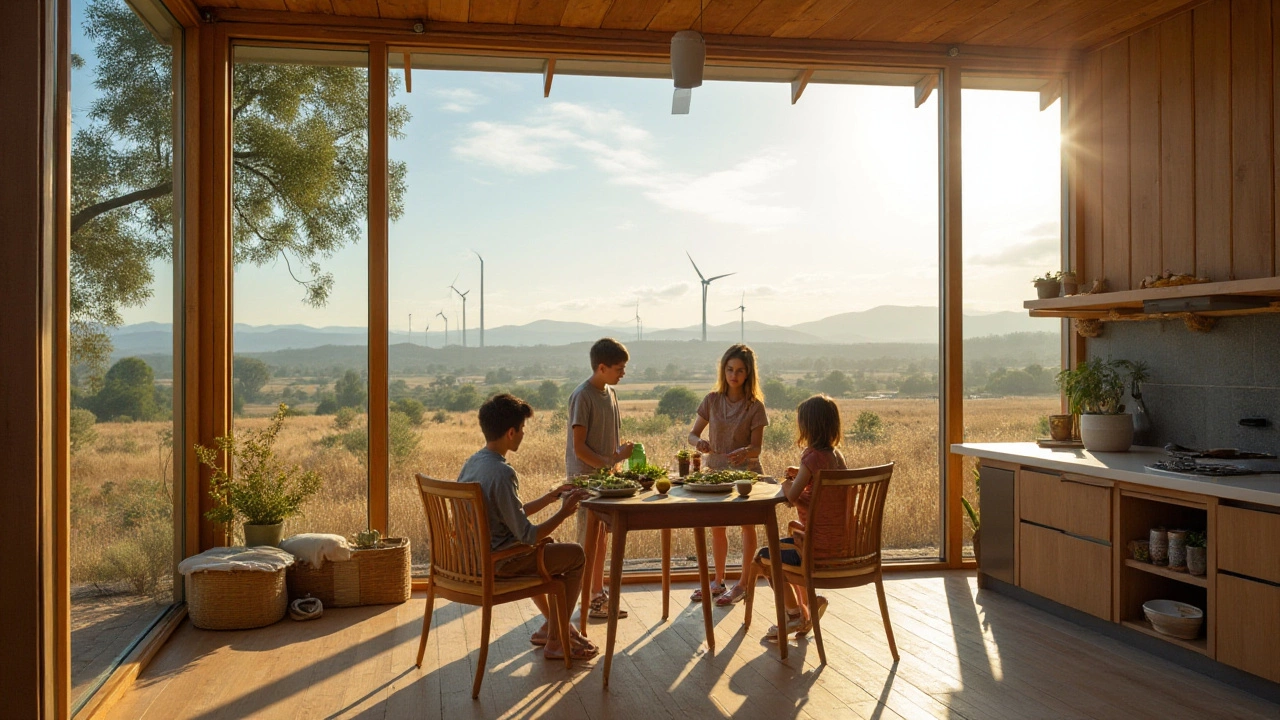Discovering the Greenest State for Eco-Friendly Cottages in the US

The idea of living in harmony with nature has taken a front seat as more people look for greener pastures. In the United States, some states have committed themselves to becoming leaders in environmental conservation, earning them the title of the 'greenest states'. As you consider where to settle down in an eco-friendly cottage, understanding what makes these places unique can help guide your decision.
Not all states share the same approach, and the way they achieve and measure their green status varies widely. This journey into ecological innovation uncovers how some leading states have adopted sustainable practices that not only preserve their lush landscapes but also cater to the increasing demand for environmentally friendly communities. Whether you're seeking to reduce your carbon footprint or simply desire the tranquility of life amidst nature's beauty, there's a lot to explore in the world of green living.
- The Green Metrics: Evaluating State Initiatives
- Pioneers in Eco-Friendly Cottages
- The States Leading the Charge
- Living Sustainably in Green States
- Tips for Choose an Eco-Friendly Cottage
The Green Metrics: Evaluating State Initiatives
Selecting the pinnacle of eco-friendliness starts with a deep dive into the heart of what makes a state truly 'green.' This evaluation isn't straightforward, as each state approaches sustainability from different angles. Various factors come into play when examining a state's commitment to the environment: from renewable energy adoption, waste management innovations, conservation policies, to the direct impact on how residents participate in sustainable living. These variables paint a broad picture of a state's eco-friendliness, and it's fascinating to explore how each piece fits into the larger puzzle.
California, for example, has carved out a reputation as a trailblazer in renewable energy. With a considerable chunk of its energy portfolio sourced from clean power, California's solar initiatives have set benchmarks worldwide. It's not unusual to see vast expanses of solar panels stretching across the golden state. Oregon, on the other hand, shines in its commitment to forestry and conservation. The state's extensive green canopy isn't just for show—the environmental policies in place are designed to protect these invaluable resources, ensuring the integrity of its lush landscapes.
Meanwhile, states like Vermont prioritize their waste management systems. With an emphasis on 'zero waste,' Vermont has pioneered multiple recycling and composting programs. This initiative reduces landfill contributions significantly, creating a cleaner environment for its residents. Vermont’s strategies serve as a model of efficient waste recycling that many other states strive to adopt.
Key Indicators of a Green State
Every state has its metrics and priorities in achieving sustainability. Some incorporate community-based initiatives that engage the populace directly into conservation efforts. Witness the 'Keep Texas Beautiful' campaign, for instance, which encourages communities to actively participate in keeping their surroundings clean and green. Such programs are crucial in fostering a culture of environmental responsibility from the grassroots level.
The vision of America's green states is spurred on by a shared responsibility, as noted by the Environmental Protection Agency: 'To achieve the ambitious goals of sustainability, collaboration between states, communities, and individuals is essential.'
| State | Main Green Initiative | Impact |
|---|---|---|
| California | Solar Energy Expansion | Leads US in solar power production |
| Oregon | Forest Conservation | Extensive preservation of natural greenery |
| Vermont | Zero Waste Efforts | High recycling rates and reduced landfill waste |
States are also placing increased emphasis on eco-friendly cottages as a housing option for those eager to embrace a sustainable lifestyle. These cottages are often built with renewable materials, employ energy-efficient systems, and make the best use of natural resources. It's not just about a greener space but creating a home that reflects a seamless integration with nature. These ecological abodes symbolize a shift toward a future where living green is not just a choice, but a way of life.
Pioneers in Eco-Friendly Cottages
Amidst the rolling hills and serene landscapes, a movement towards sustainable living has taken root in the form of eco-friendly cottages. These charming abodes offer more than just a tranquil retreat; they stand as testaments to the innovative spirit driving environmental conservation. From solar panels cascading across their rooftops to floors made of reclaimed wood, these cottages are much more than mere living spaces. They embody a lifestyle choice, a commitment to reducing one's ecological footprint in meaningful ways. In several states across the U.S., such as Vermont and Oregon, initiatives to encourage these sustainable dwellings have gained momentum, supported by both local governments and enthusiastic communities.
States like Vermont have been at the forefront, thanks to their strong advocacy for sustainable living. Vermont is celebrated for its picturesque landscapes and its dedication to preserving the environment. This tiny New England state has woven sustainability into its fabric, encouraging the construction of eco-friendly homes that blend seamlessly with their natural surroundings. Here, essential features such as efficient heating systems and green roofs that help manage stormwater run-off are integrated into everyday building practices. Vermont is not alone in this endeavor; Oregon, with its lush forests and commitment to *sustainable living*, is another key player. Known for its progressive environmental policies, Oregon has fostered a community of architects and builders dedicated to creating cottages that honor the state's stunning natural heritage.
Eco-friendly cottages are much more than architectural feats; they embrace innovative technologies that minimize environmental impact. For instance, the latest designs incorporate smart home technologies that optimize energy use, while greywater systems help in recycling water for irrigation purposes. By prioritizing locally sourced materials, these homes reduce transportation emissions and invigorate local economies. It’s fascinating how some of these cottages even utilize living walls, which not only contribute to improved air quality but also add an element of natural beauty, making these structures an artistic interpretation of living with nature.
An interesting fact to note is the rising popularity of "tiny house" communities in these green states. These communities emphasize simplicity and conscious living, often featuring tiny eco-friendly cottages that utilize space and resources smartly.
"Living in a tiny home forces you to reevaluate your essentials and make purposeful choices about your environment," notes Sarah Susanka, an author known for advocating smaller living spaces.Such communities are burgeoning especially in regions like California and Colorado, where residents seek to escape the typical urban sprawl and instead focus on forging deeper connections with their surroundings.
In these pioneering states, the movement toward eco-friendly cottages is buttressed not only by environmental motivations but also by government incentives encouraging sustainable development. Tax breaks, grants, and expedited permitting processes are just a few examples of how authorities are supporting this green venture. As these states champion innovations in environmental conservation, they set benchmarks for others to follow. The journey from conventional living to these groundbreaking cottages might be gradual, but with pioneers like Vermont and Oregon at the helm, the shift towards a more sustainable way of life seems not just possible, but inevitable.

The States Leading the Charge
When it comes to spearheading the movement towards a more sustainable future, certain states in the US are setting remarkable examples. Among them, California stands out prominently. Known for its robust environmental policies and initiatives, the state has long been a champion of green energy and conservation. California's commitment to sustainability is evident in its rigorous measures to reduce carbon emissions and promote renewable energy sources. With its ambitious goals to transition entirely to renewable energy by 2045, California is undoubtedly leading the charge.
Oregon is another state that has established itself as a front-runner in environmental conservation. Nestled along the Pacific coast, it boasts a natural landscape that inspires eco-friendly living. The state has implemented comprehensive policies to protect its forests and wildlife. By prioritizing clean energy investments and encouraging residents to adopt solar power, Oregon has created a model for sustainable living that others are eager to emulate. Eco-friendly cottages here are crafted to blend seamlessly with the surroundings, often incorporating sustainable building materials and systems designed to minimize environmental impact.
Colorado, with its breathtaking mountain vistas, has also emerged as a leader in promoting green practices. The state's initiative to preserve its pristine landscapes includes comprehensive waste reduction programs and incentives for adopting energy-efficient technologies. In fact, Colorado communities, like Aspen, have set benchmarks by pushing towards 100% renewable energy sources, long before the deadlines others have set. Such a commitment is evident in the widespread implementation of eco-friendly cottages designed to merge modern comfort with environmental consciousness.
With Vermont on the list, it is hardly surprising given its historical advocacy for environmental integrity. Known for its picturesque terrains, Vermont takes pride in its efforts to maintain biodiversity and environmental health. Statewide programs like efficiency Vermont and incentives for building eco-friendly cottages lay a foundation for responsible living. Through community-based efforts, residents are encouraged to engage in practices that significantly reduce their environmental footprint, making Vermont's journey toward sustainability truly a collective one.
One cannot overlook the strides being made by Washington state, known for its lush evergreen forests and vibrant eco-culture. The state's commitment to sustainability is embedded in its innovative approaches to energy use, reducing water consumption, and preserving its vast green spaces. What sets Washington apart is its focus on holistic conservation practices, ensuring that future generations inherit a planet in harmony with nature's design. Initiatives like the "greener Seattle" plan showcase their ambitious intentions, focusing on increasing urban green spaces and reducing overall environmental impact.
"The significance of these states taking active roles in environmental stewardship cannot be overstated. They serve as beacons of hope and guidance, reflecting a brighter path towards a sustainable future." - National Geographic
As these states continue to innovate and implement green policies, they not only lead the charge internally but also inspire others across the nation to rethink their approach to environmental conservation. In the quest to find the greenest state, one discovers that these leaders exemplify what is possible when dedication meets action. The journey of each state is unique, but together they contribute to a collective movement towards a more sustainable, eco-friendly nation.
Living Sustainably in Green States
Embracing a sustainable lifestyle in the greenest state transforms not only your ecological footprint but also your connection with nature. Across the United States, these states have made significant strides to promote sustainable living, creating an inviting environment for those keen on minimizing their impact on the planet. These emerging paradises have intricately interwoven sustainability into multiple facets of daily life, providing residents with access to greener options and setting examples for others to follow. The strategic methodologies employed by these states reflect their unwavering commitment to environmental stewardship—each taking unique measures to foster a sustainable culture. From policy initiatives that encourage renewable energy to community programs that promote recycling and conservation efforts, every aspect of living is geared towards reducing carbon emissions and nurturing biodiversity.
One notable example is Vermont, renowned for its dedication to preserving its lush, verdant landscapes. The state consistently ranks highly due to its ambitious renewable energy programs, often harnessing wind and solar power to meet its energy needs. Vermont’s commitment to eco-friendly practices encourages widespread participation in sustainable living, spearheading initiatives such as the 'Eco Cottages' movement that aims to provide sustainable housing options without compromising comfort. Vermont's approach to sustainability often serves as an inspiration, celebrated not only for its policies and green innovations but also by architects and planners who wish to mitigate climate change impacts through thoughtful design.
At the heart of these communities is a strong emphasis on education and collaboration. Community centers and local governments work hand in hand to ensure citizens are well-informed about the best practices for energy efficiency, waste reduction, and sustainable agriculture. Workshops and seminars are common, fostering a sense of collective responsibility and equipping residents with the tools and knowledge they need to contribute positively to their environment. As a result, sustainable culture thrives, creating a supportive network of like-minded individuals working towards a common goal.
Quote from David Orr, a prominent leader in the field of environmental design, encapsulates the ethos of these green states, 'The planet does not need more successful people. But it does desperately need more peacemakers, healers, restorers, storytellers and lovers of every kind.' His words serve as a reminder of the fundamental importance of nurturing a symbiotic relationship with the earth, values deeply embedded in the lives of those residing in these states. Encouraging local produce consumption, reducing dependency on automobiles, and designing energy-efficient buildings form substantial parts of the state's efforts to lower their carbon footprint, championing the cause for sustainable living each day.
Moreover, a supportive legislative environment reinforces these values, offering tax incentives and rebates for adopting green practices or retrofitting existing structures to align with environmental standards. This not only benefits homeowners seeking to renovate their properties to make them more eco-friendly but also encourages businesses to explore sustainable business models. Through these efforts, the greenest states set benchmarks on how sustainable living can benefit not just the community, but eventually, the global ecosystem as well. With innovations stemming from progressive policies and community-driven initiatives, living sustainably in green states embodies a harmonious balance of modern conveniences and environmental consciousness.

Tips for Choosing an Eco-Friendly Cottage
Finding the perfect eco-friendly cottage can be an exciting yet daunting task. One must consider a myriad of factors, ranging from the materials used in the construction to the cottage's integration into the local ecosystem. First and foremost, look for cottages constructed with sustainable materials. Does the structure use reclaimed wood, recycled steel, or other eco-conscious materials? When future-proofing a home, consider these essentials as they significantly reduce the environmental impact.
Sustainability should extend beyond construction materials. The cottage's location plays a crucial role in its eco-friendliness. Selecting a spot that minimizes deforestation and promotes native vegetation is ideal. Locations that are near public transport systems can lower the need for personal vehicles, which is a plus for reducing one's carbon footprint. In assessing a greenest state, check how it manages land development and protects local flora and fauna. Many states like California have stringent land-use policies aimed at conserving biodiversity.
"Living sustainably is about more than just reducing harm; it's about rethinking our relationship with the Earth," said environmentalist Dr. Sarah Belford.Energy efficiency is another paramount consideration. Seek cottages with comprehensive energy-efficient systems, such as solar panels, energy-efficient windows, and high-quality insulation. These features will not only save on utility bills but also significantly lower the demand on natural resources. An energy-efficient design, like those found in eco-friendly cottages, is often the most sustainable and practical choice for green living.
Waste management practices within the property are equally important. How does the cottage handle waste? Is there a composting system in place? Perhaps there are incentives for recycling. A well-planned system can ensure that waste is minimized, with reusable options prioritized. Rainwater harvesting and graywater systems can boost irrigation, illustrating superior resource management practices. A cottage that adopts such innovative solutions aligns with sustainable living standards in many of the most sustainable states like Washington and Oregon.
For those keen on self-sufficiency, evaluating the potential for home gardening is advisable. Check for any restrictions on planting edible landscapes or installing greenhouse setups. Growing your own vegetables not only provides a fresh food source but also contributes to reducing food miles. Statistics show that households who engage in urban gardening can cut up to 15% off their carbon emissions. Integrate yourself into a community that values these practices, encouraging collaboration and sustainability among residents. This holistic view is imperative when selecting an eco-conscious dwelling.